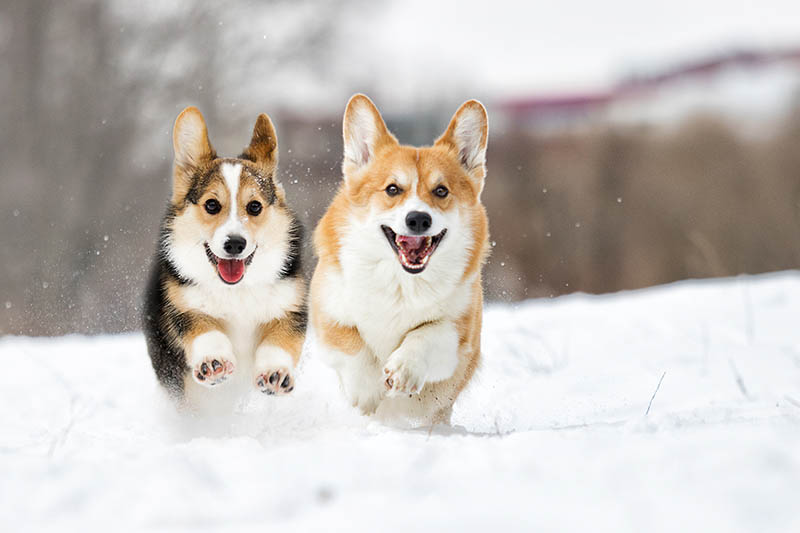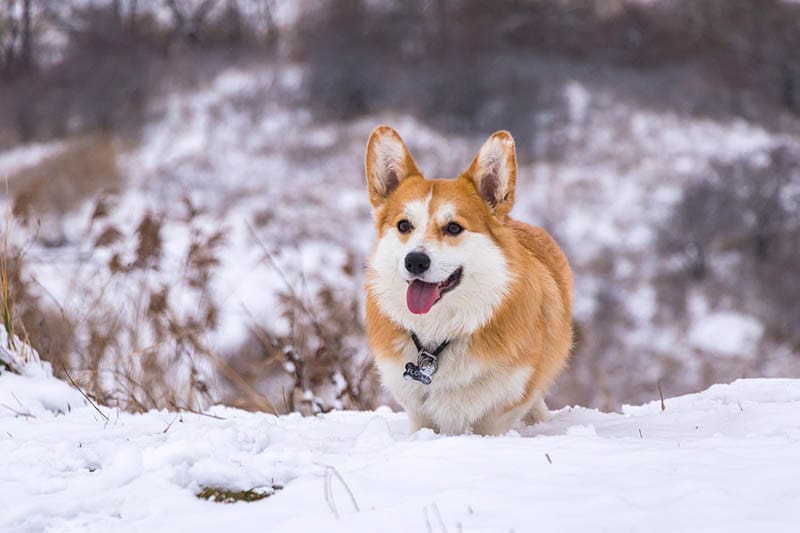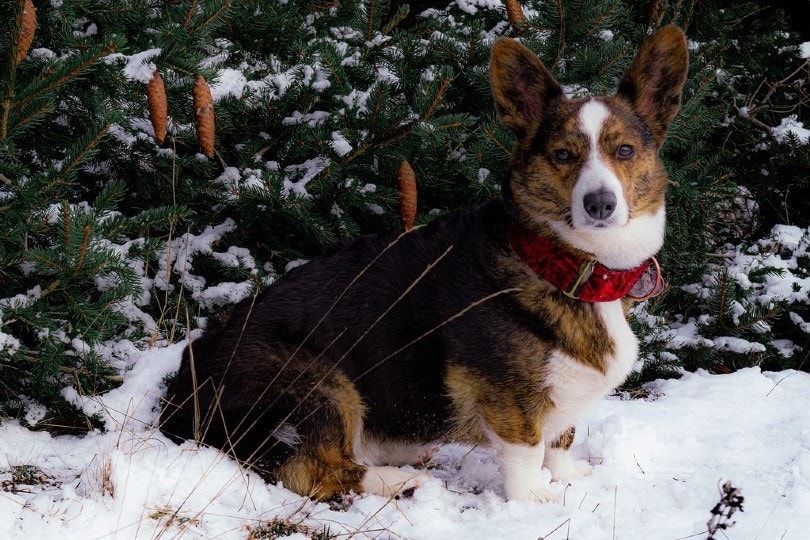Do Corgis Like Snow or Cold Weather? Important Care Facts
Updated on

Few dogs are as interesting as the Corgi. That’s mainly because they look like a full-size dog except for their legs, which are so short that they appear almost ridiculous. Indeed, of all the dogs trained for herding over the centuries, Corgis are by far the shortest, with stubby legs that look like they belong on a different dog (or another animal altogether).
You would think their short legs would make them afraid of the snow, as a Corgi would likely disappear if there were more than a few inches of white stuff on the ground. The opposite is true, however, as Corgis immensely enjoy the cold and snow. With their thick double coats, Corgis are made for romping and playing in the snow and will go outside even in frigid weather.
Do you want to know more about Corgis, including their traits, habits, and care when it’s cold outside? If yes, read on! Below are various facts, figures, and interesting tidbits about this playful, affectionate dog breed for your reading enjoyment!
What Makes a Corgi So Good for Cold Weather?
The main reason Corgis do well in the cold and snow is their double coat, which is highly resistant to cold. The top coat on the Corgi protects them from the sun and from getting sunburned on a sunny day. This coat is thinner and longer, like most dogs with a double coat.
Their undercoat, however, protects Corgis from the snow and cold most by providing a layer of thick insulation. This second layer is thicker and shorter and feels coarse to the touch. That’s not to say that Corgis can handle the cold like a Siberian Husky or Alaskan Malamute; their thick coat helps them stay warm enough to enjoy the snow and cold for short periods. Besides their double coat, the Corgi has no other attributes that make it a good cold-weather dog.

How Cold Is Too Cold for a Corgi?
While Corgis like the cold and will happily play with you in the snow as long as you like, they aren’t meant to be outside winter dogs. Unlike true cold-weather dogs, Corgis can easily get frostbite, which is very painful and can be deadly. That’s why dog experts recommend bringing your Corgi inside at night in winter when there’s snow or ice on the ground.
Like many animals, Corgis enjoy the snow because it’s so different from anything else they encounter in their lives. Their paws, however, are fully exposed to the cold, and that exposure risk increases significantly once they get wet. Although your Corgi might enjoy going out and romping with you after a good snowfall, leaving them out in the cold is not recommended and can be dangerous, if not deadly, for your dog.
The 5 Signs That Your Corgi Is Cold
Like most animals, your Corgi will have several telltale signs if they start getting too cold and need to go back inside. Some of these signs might be noticeable even if your Corgi is still willfully playing with you in the snow.
1. Your Corgi Is Shivering
It’s very rare to see a Corgi shiver because its double coat is so thick and warm. If you see your Corgi start to shiver, even if it’s not constant, that’s a sure sign they’re cold and need to go inside.
2. Your Corgi Curls Up in the Snow
Most dogs will curl up into a tight ball when they’re cold. In this position, they can keep more of their body heat from escaping. If your Corgi curls up outside in the snow or chilly weather, it’s a good sign they’re cold.
3. Your Corgi Starts Whining
Corgis are very communicative; if they’re unhappy or bothered by something, they will whine and fuss to let you know. If you’re outside in the cold when they start to whine, that likely means your Corgi is cold and wants to go inside and warm up.
4. Your Corgi Is Walking in an Unusual Way
We mentioned earlier that a Corgi’s paws aren’t protected from the cold, which can lead their toes to get colder much faster than their body. If you notice that your Corgi is walking oddly, limping, or otherwise not walking like normal, their feet are probably cold and hurting, and you should bring them inside.
5. You Corgi Is Having Trouble Staying Awake
Bring your Corgi inside immediately if they won’t get up and walk or you can’t get them to wake up when they’re outside. This sign is one of the worst you will see in your Corgi and is a sure sign they’re dangerously cold.

Do Corgis Need a Sweater or Other Protection From the Cold?
If you plan to play outside in the snow often with your Corgi, you should consider getting them a sweater, jacket, or another piece of clothing to keep them warm. Thanks to their double coat, Corgis don’t particularly need a sweater to be comfortable and have a good time. They might not like wearing a sweater, either. But, if you go on a long walk when it’s cold outside, the average Corgi will be glad to have the extra protection.
A waterproof jacket is one thing you might consider more than a sweater for your Corgi. Why? When it’s dry and cold, your Corgi’s coat will stay dry and protect its body from the cold very well. However, when it’s raining or snowing, your Corgi’s coat will eventually get wet, and a wet coat is a far worse protection from the cold than a dry coat. In other words, protecting your Corgi from getting wet is more important than protecting them from getting cold.
Another consideration if you want to stay outside longer with your Corgi when it’s cold is to bring out a blanket or dog bed they can relax on. That way, your pup can warm up for a few minutes while you both take a break from having snow-time fun.
Do Corgis Thrive in Warm Weather?
With all this talk about Corgis being able to handle the cold and snow, we haven’t touched on the opposite: heat and sun. It’s normal to assume that, with a double coat, Corgis might not be a great fit in places where the weather is always hot and humid. But is that assumption correct?
Surprisingly, Corgis can and do live in areas of the United States where the temperatures are typically high. That’s thanks partly to where Corgis were first bred, in the country of Wales, which is part of Great Britain. In Wales, Corgis were bred as sheepdogs and herd guardians and meant to stay outside for hours regardless of the weather.
The thing about Wales is that they have all four seasons, with brutally cold winters and sunny, hot summers. Like many dog breeds, Corgis adapted to the changing temperature by growing or shedding their longer outer coat. They shed their inner coat, too, but that happens all year.
Should you adopt a Corgi if, for example, you live in Florida, Texas, Arizona, or one of the other hot states in the US? Probably not, because the temperature would be overwhelming for them. If you kept your Corgi indoors and walked them when the temperatures were cooler, they would probably be OK.
What’s the Best Temperature Range for a Corgi?
The best temperature range for a Corgi is between 85℉ and 59℉, give or take a few degrees. That’s not to say that you can’t adopt a Corgi if you live where the temps are higher or lower, just that your Corgi would be uncomfortable when they’re outside. Knowing this, you should do your best to keep them inside when the temperature is much higher than 85℉ and much lower than 59℉.
Experts don’t recommend having a Corgi if you live where the weather is tropical year-round. The reason is humidity, which makes it very difficult for a Corgi or any dog with a double coat to cool itself off by panting.

What Dog Breeds Love the Cold and Snow?
While Corgis will play in the snow and aren’t bothered by short periods in the cold, some dogs are made for cold weather. If you haven’t adopted yet and are wondering which dogs will truly excel in cold weather, we’ve listed some of them for you below.
Final Thoughts
As we’ve seen today, Corgis like the snow and cold weathe and, with their double coats, are well-prepared to handle frigid temperatures. However, it’s not recommended that you keep a Corgi outside in the cold for longer than 30 minutes to an hour unless they have extra protection against the cold. Also, it’s essential that you keep your Corgi’s coat dry when they’re out in the cold. You’ll need to buy your Corgi a dog-sized raincoat for longer sessions in the snow.
If you’ve just adopted a Corgi, congratulations! You’ll find that they will make an excellent addition to your family. Have fun playing with your Corgi in the snow this winter!
Related Read:
- Can Corgis Be Left Alone? Time Limits & Considerations
- How Much Exercise Do Corgis Need? Everything You Need to Know!
Featured Image Credit: Happy monkey, Shutterstock












